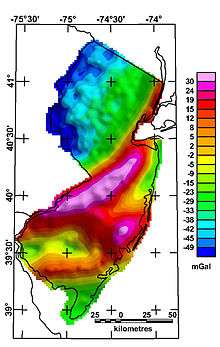Bouguer anomaly
In geodesy and geophysics, the Bouguer anomaly (named after Pierre Bouguer) is a gravity anomaly, corrected for the height at which it is measured and the attraction of terrain. The height correction alone gives a free-air gravity anomaly.

Anomaly
The Bouguer anomaly is related to the observed gravity as follows:
Here,
- is the Bouguer anomaly;
- is the observed gravity;
- is the correction for latitude (because the Earth is not a perfect sphere);
- is the free-air correction;
- is the Bouguer correction which allows for the gravitational attraction of rocks between the measurement point and sea level;
- is the free-air gravity anomaly.
- is a terrain correction which allows for deviations of the surface from an infinite horizontal plane
A Bouguer reduction is called simple or incomplete if the terrain is approximated by an infinite flat plate called the Bouguer plate. A refined or complete Bouguer reduction removes the effects of terrain precisely. The difference between the two, the differential gravitational effect of the unevenness of the terrain, is called the terrain effect. It is always negative.[1]
Simple reduction
The gravitational acceleration outside a Bouguer plate is perpendicular to the plate and towards it, with magnitude 2πG times the mass per unit area, where is the gravitational constant. It is independent of the distance to the plate (as can be proven most simply with Gauss's law for gravity, but can also be proven directly with Newton's law of gravity). The value of is 6.67 × 10−11 N m2 kg−2, so is 4.191 × 10−10 N m2 kg−2 times the mass per unit area. Using 1 Gal = 0.01 m s−2 (1 cm s−2) we get 4.191 × 10−5 mGal m2 kg−1 times the mass per unit area. For mean rock density (2.67 g cm−3) this gives 0.1119 mGal m−1.
The Bouguer reduction for a Bouguer plate of thickness is
where is the density of the material and is the constant of gravitation.[1] On Earth the effect on gravity of elevation is 0.3086 mGal m−1 decrease when going up, minus the gravity of the Bouguer plate, giving the Bouguer gradient of 0.1967 mGal m−1.
More generally, for a mass distribution with the density depending on one Cartesian coordinate z only, gravity for any z is 2πG times the difference in mass per unit area on either side of this z value. A combination of two equal parallel infinite plates does not produce any gravity inside.
See also
Notes
- 1 2 Hofmann-Wellenhof & Moritz 2006, Section 3.4
References
- Lowrie, William (2004). Fundamentals of Geophysics. Cambridge University Press. ISBN 0-521-46164-2.
- Hofmann-Wellenhof, Bernard; Moritz, Helmut (2006). Physical Geodesy (2nd. ed.). Springer. ISBN 978-3-211-33544-4.
External links
- Bouguer anomalies of Belgium. The blue regions are related to deficit masses in the subsurface
- Bouguer gravity anomaly grid for the conterminous US by the [United States Geological Survey].
- Bouguer anomaly map of Grahamland F.J. Davy (et al.), British Antarctic Survey, BAS Bulletins 1963-1988
- Bouguer anomaly map depicting south-eastern Uruguay's Merín Lagoon anomaly (amplitude greater than +100 mGal), and detail of site.
- List of Magnetic and Gravity Maps by State by the [United States Geological Survey].